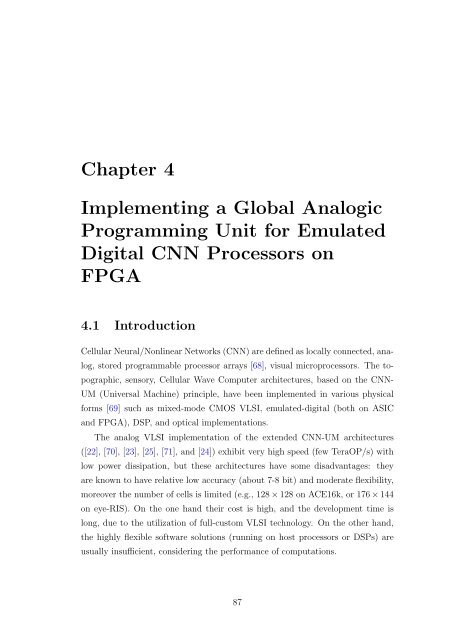PPKE ITK PhD and MPhil Thesis Classes
PPKE ITK PhD and MPhil Thesis Classes
PPKE ITK PhD and MPhil Thesis Classes
Create successful ePaper yourself
Turn your PDF publications into a flip-book with our unique Google optimized e-Paper software.
Chapter 4<br />
Implementing a Global Analogic<br />
Programming Unit for Emulated<br />
Digital CNN Processors on<br />
FPGA<br />
4.1 Introduction<br />
Cellular Neural/Nonlinear Networks (CNN) are defined as locally connected, analog,<br />
stored programmable processor arrays [68], visual microprocessors. The topographic,<br />
sensory, Cellular Wave Computer architectures, based on the CNN-<br />
UM (Universal Machine) principle, have been implemented in various physical<br />
forms [69] such as mixed-mode CMOS VLSI, emulated-digital (both on ASIC<br />
<strong>and</strong> FPGA), DSP, <strong>and</strong> optical implementations.<br />
The analog VLSI implementation of the extended CNN-UM architectures<br />
([22], [70], [23], [25], [71], <strong>and</strong> [24]) exhibit very high speed (few TeraOP/s) with<br />
low power dissipation, but these architectures have some disadvantages: they<br />
are known to have relative low accuracy (about 7-8 bit) <strong>and</strong> moderate flexibility,<br />
moreover the number of cells is limited (e.g., 128 × 128 on ACE16k, or 176 × 144<br />
on eye-RIS). On the one h<strong>and</strong> their cost is high, <strong>and</strong> the development time is<br />
long, due to the utilization of full-custom VLSI technology. On the other h<strong>and</strong>,<br />
the highly flexible software solutions (running on host processors or DSPs) are<br />
usually insufficient, considering the performance of computations.<br />
87






![optika tervezés [Kompatibilitási mód] - Ez itt...](https://img.yumpu.com/45881475/1/190x146/optika-tervezacs-kompatibilitasi-mad-ez-itt.jpg?quality=85)









